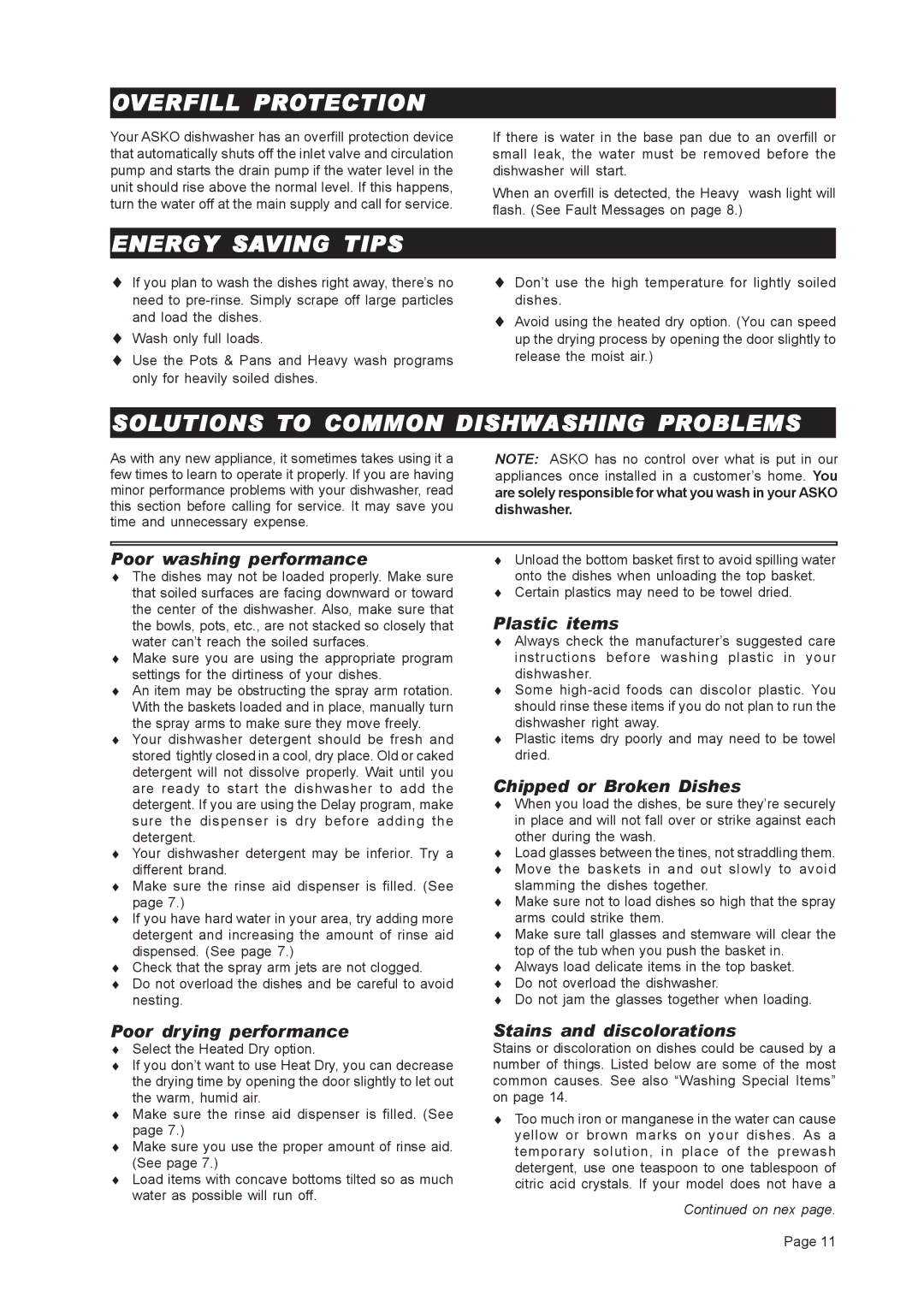
OVERFILL PROTECTION
Your ASKO dishwasher has an overfill protection device that automatically shuts off the inlet valve and circulation pump and starts the drain pump if the water level in the unit should rise above the normal level. If this happens, turn the water off at the main supply and call for service.
If there is water in the base pan due to an overfill or small leak, the water must be removed before the dishwasher will start.
When an overfill is detected, the Heavy wash light will flash. (See Fault Messages on page 8.)
ENERGY SAVING TIPS
♦If you plan to wash the dishes right away, there’s no need to
♦Wash only full loads.
♦Use the Pots & Pans and Heavy wash programs only for heavily soiled dishes.
♦Don’t use the high temperature for lightly soiled dishes.
♦Avoid using the heated dry option. (You can speed up the drying process by opening the door slightly to release the moist air.)
SOLUTIONS TO COMMON DISHWASHING PROBLEMS
As with any new appliance, it sometimes takes using it a | NOTE: ASKO has no control over what is put in our |
few times to learn to operate it properly. If you are having | appliances once installed in a customer’s home. You |
minor performance problems with your dishwasher, read | are solely responsible for what you wash in your ASKO |
this section before calling for service. It may save you | dishwasher. |
time and unnecessary expense. |
|
|
|
|
|
Poor washing performance | ♦ Unload the bottom basket first to avoid spilling water |
♦ The dishes may not be loaded properly. Make sure | onto the dishes when unloading the top basket. |
that soiled surfaces are facing downward or toward | ♦ Certain plastics may need to be towel dried. |
the center of the dishwasher. Also, make sure that | Plastic items |
the bowls, pots, etc., are not stacked so closely that | |
water can’t reach the soiled surfaces. | ♦ Always check the manufacturer’s suggested care |
♦ Make sure you are using the appropriate program | instructions before washing plastic in your |
settings for the dirtiness of your dishes. | dishwasher. |
♦ An item may be obstructing the spray arm rotation. | ♦ Some |
With the baskets loaded and in place, manually turn | should rinse these items if you do not plan to run the |
the spray arms to make sure they move freely. | dishwasher right away. |
♦ Your dishwasher detergent should be fresh and | ♦ Plastic items dry poorly and may need to be towel |
stored tightly closed in a cool, dry place. Old or caked | dried. |
detergent will not dissolve properly. Wait until you | Chipped or Broken Dishes |
are ready to start the dishwasher to add the | |
detergent. If you are using the Delay program, make | ♦ When you load the dishes, be sure they’re securely |
sure the dispenser is dry before adding the | in place and will not fall over or strike against each |
detergent. | other during the wash. |
♦ Your dishwasher detergent may be inferior. Try a | ♦ Load glasses between the tines, not straddling them. |
different brand. | ♦ Move the baskets in and out slowly to avoid |
♦ Make sure the rinse aid dispenser is filled. (See | slamming the dishes together. |
page 7.) | ♦ Make sure not to load dishes so high that the spray |
♦ If you have hard water in your area, try adding more | arms could strike them. |
detergent and increasing the amount of rinse aid | ♦ Make sure tall glasses and stemware will clear the |
dispensed. (See page 7.) | top of the tub when you push the basket in. |
♦ Check that the spray arm jets are not clogged. | ♦ Always load delicate items in the top basket. |
♦ Do not overload the dishes and be careful to avoid | ♦ Do not overload the dishwasher. |
nesting. | ♦ Do not jam the glasses together when loading. |
Poor drying performance
♦Select the Heated Dry option.
♦If you don’t want to use Heat Dry, you can decrease the drying time by opening the door slightly to let out the warm, humid air.
♦Make sure the rinse aid dispenser is filled. (See page 7.)
♦Make sure you use the proper amount of rinse aid. (See page 7.)
♦Load items with concave bottoms tilted so as much water as possible will run off.
Stains and discolorations
Stains or discoloration on dishes could be caused by a number of things. Listed below are some of the most common causes. See also “Washing Special Items” on page 14.
♦Too much iron or manganese in the water can cause yellow or brown marks on your dishes. As a temporary solution, in place of the prewash detergent, use one teaspoon to one tablespoon of citric acid crystals. If your model does not have a
Continued on nex page.
Page 11
